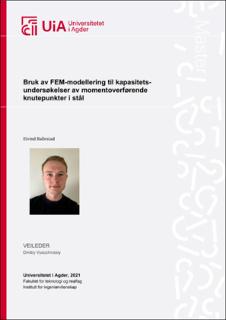| dc.contributor.author | Ballestad, Eivind | |
| dc.date.accessioned | 2021-09-15T10:43:46Z | |
| dc.date.available | 2021-09-15T10:43:46Z | |
| dc.date.issued | 2021 | |
| dc.identifier.citation | Ballestad, E. (2021) Bruk av FEM-modellering til kapasitetsundersøkelser av momentoverførende knutepunkter i stål (Master's thesis). University of Agder, Grimstad | en_US |
| dc.identifier.uri | https://hdl.handle.net/11250/2777391 | |
| dc.description | Master's thesis in Civil and structural engineering (BYG508) | en_US |
| dc.description.abstract | Eurocode 3 provides a rough analytical method to estimate the capacity of a steel joint by derivingthe overall behavior from its components. Numerical methods such as the finite element method(FEM) enable accurate simulation of joint behavior. However, there is no direct guidelines inthe Eurocodes for utilizing numerical methods to document the capacity of moment-resisting steeljoints. This master thesis investigates how FEM can be used to evaluate and document the capacityof such joints. A literature review that includes relevant normative documentation and researcharticles dealing with the use of FEM has been carried out and a semi-rigid steel joint has beeninvestigated by numerical and analytical methods. The normative documentation investigated inthis thesis allows for the use of non-linear FEM analyzes for capacity evaluations of steel componentsin ultimate limit state but are not directly intended for use on bolted joints. In a research context,there are no strict rules for how modeling using FEM must be carried out, but the commonfeatures of FEM models of joints used for research purposes includes modeling, calibration andvalidation to simulate the observed behavior from experimental tests. When comparing resultsfrom the use of FEM modeling after guidelines given in the normative documentation with resultsfrom the analytical methods in Eurocode 3, it becomes clear that the numerical method generallyyields higher strength and lower stiffness. Modeling should be done in accordance with relevantnormative documents so that it can be proven through documentation that the model has sufficientsafety against statistical variations and other uncertainties. The use of FEM as a dimensioning toolrequires that the engineer has knowledge about the finite element method and can utilize therelevant analysis software. Furthermore, the engineer is responsible for ensuring that the model isrepresentative of the joint and can produce reliable results. | en_US |
| dc.language.iso | nob | en_US |
| dc.publisher | University of Agder | en_US |
| dc.rights | Attribution-NonCommercial-NoDerivatives 4.0 Internasjonal | * |
| dc.rights.uri | http://creativecommons.org/licenses/by-nc-nd/4.0/deed.no | * |
| dc.subject | BYG508 | en_US |
| dc.title | Bruk av FEM-modellering til kapasitetsundersøkelser av momentoverførende knutepunkter i stål | en_US |
| dc.type | Master thesis | en_US |
| dc.rights.holder | © 2021 Eivind Ballestad | en_US |
| dc.subject.nsi | VDP::Teknologi: 500::Bygningsfag: 530::Konstruksjonsteknologi: 533 | en_US |
| dc.source.pagenumber | 109 | en_US |

